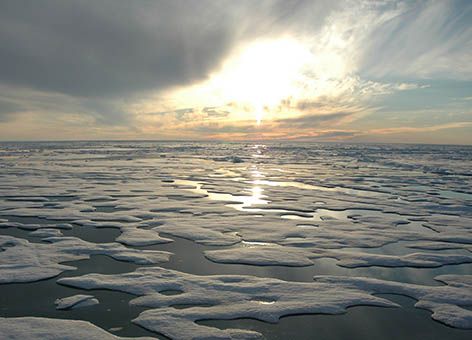NOAA Launches ERMA Mapping Tool for Responding to Arctic Oil Spills
JULY 31, 2012 — The uncertain, rapidly changing conditions of the Arctic Ocean call for emergency responders to take extra precautions in preparing for the possibility of a remote oil spill. Because of this, NOAA's Office of Response and Restoration, along with the Department of the Interior’s Bureau of Safety and Environmental Enforcement (BSEE), have launched an Environmental Response Management Application (ERMA®) for the Arctic region.
Arctic ERMA, the same interactive online mapping tool used by federal responders during the Deepwater Horizon/BP oil spill, will help address the many complex challenges the Arctic presents. This comes at a key time for the area, as growing ship traffic and proposed energy development, including offshore drilling, are increasing the risk of oil spills. ERMA brings together all of the available information needed for an effective emergency response in the Arctic. In an emergency situation, ERMA is equipped with constantly updated oceanographic observations and weather data from NOAA as well as critical information from BSEE and other federal and state response agencies. Depending on the need, responders can further customize the tool with environmental, logistical, and operational data, such as areas where sensitive species may be, fisheries may be closed, or navigation may be restricted.
"Arctic ERMA builds on the lessons we learned on usability, data management, and data visualization from the Deepwater Horizon/BP disaster," commented Dr. Amy Merten, OR&R Spatial Data Branch Manager. "The Arctic ERMA team is thrilled to work with our diverse group of partners, ranging from Alaskan village elders to federal agencies, as they challenge us in how we share data and visualize information that can improve our collective oil spill preparedness. The Arctic ERMA site is now live, but it's a living work in progress."
Dr. Merten led the team developing Arctic ERMA. Integrating and synthesizing data—some in real time—into a single interactive map, ERMA provides a quick visualization of the situation, improving communication and coordination among responders and environmental stakeholders. NOAA developed Arctic ERMA to address escalating energy exploration and transportation activity in the region, which increases the risk of oil spills and other accidents. The Alaska Ocean Observing System; the State of Alaska; the University of Alaska, Fairbanks; the University of New Hampshire; and Alaska’s Northwest and North Slope Arctic Boroughs are working with NOAA to keep this database current with information as it becomes available.
Arctic ERMA pulls into one platform data such as the location, extent, and concentration of sea ice; locations of ports and pipelines; and vulnerable environmental resources. This tool also includes cultural and subsistence resources based on traditional and local knowledge. In addition to providing local and natural resource information, BSEE has helped improve access to key environmental, commercial, and industrial data sources throughout lease areas in the Arctic. BSEE and other organizations will optimize real-time sensors to feed the data directly into ERMA during both potential oil spills and exercises simulating the release of hazardous materials. You can view Arctic ERMA online at https://www.erma.unh.edu/arctic. Earlier this summer, NOAA, BSEE, and the U.S. Coast Guard used Arctic ERMA during an industry-sponsored training exercise simulating an oil spill in the Chukchi Sea.
"It's an incredibly popular tool," said John Whitney, NOAA's Scientific Support Coordinator for Alaska. "My colleagues responding to oil spills in local, state, and federal government as well as industry continue to give very positive feedback about how valuable Arctic ERMA will be when they are trying to get information about a spill."
Arctic ERMA is the product of a partnership among NOAA's Office of Response and Restoration, NOAA's Office of Ocean and Coastal Resource Management, the Oil Spill Recovery Institute, DOI's Bureau of Safety and Environmental Enforcement, and the University of New Hampshire's Coastal Response Research Center. Besides the Arctic, ERMA is currently available for seven other geographic regions. The launch of Arctic ERMA is part of ongoing efforts by the Interagency Working Group on Coordination of Domestic Energy Development and Permitting in Alaska, which President Obama established in July 2011. This working group aims to coordinate the federal agencies responsible for overseeing the safe and responsible development of onshore and offshore energy in Alaska. Read the press release.
 An official website of the United States government.
An official website of the United States government. 

